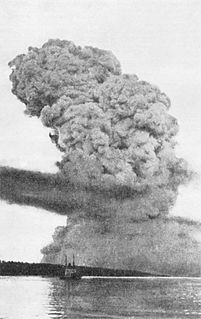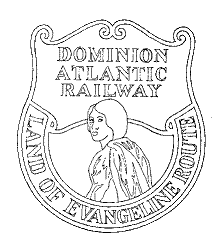
The Halifax Explosion was a disaster that occurred in Halifax, Nova Scotia, Canada, on the morning of 6 December 1917. SS Mont-Blanc, a French cargo ship laden with high explosives, collided with the Norwegian vessel SS Imo in the Narrows, a strait connecting the upper Halifax Harbour to Bedford Basin. A fire on board the Mont-Blanc led to a massive explosion that devastated the Richmond district of Halifax. Approximately 2,000 people were killed, largely in Halifax and Dartmouth, by the blast, debris, fires, or collapsed buildings, and an estimated 9,000 others were injured. The blast was the largest human-made explosion at the time, releasing the equivalent energy of roughly 2.9 kilotons of TNT (12 TJ).

The Dominion Atlantic Railway was a historic railway which operated in the western part of Nova Scotia in Canada, primarily through an agricultural district known as the Annapolis Valley.

SS Royal William was a Canadian side-wheel paddle steamship that is sometimes credited with the first crossing of the Atlantic Ocean almost entirely under steam power, in 1833, using sails only during periods of boiler maintenance. She was the largest passenger ship in the world from 1831 to 1839. Earlier vessels that crossed partially under steam include the British-built Dutch-owned Curaçao in 1827 and the sail-steam hybrid SS Savannah in 1819.

HMCS Hochelaga was a commissioned patrol vessel of the Royal Canadian Navy (RCN) that served in World War I and postwar until 1920. Hochelaga is a historic name associated with Canada, the voyages of Jacques Cartier, and the city of Montreal. Initially constructed as the yacht Waturus in 1900 in Europe, the vessel was sold to an American in 1902. The ship was acquired in 1914 for use as a patrol vessel on the East Coast of Canada. Following World War I, the vessel became a ferry between Prince Edward Island and Nova Scotia. After World War II the ship was renamed HaChayal Ha'Ivri and used for illegal Jewish immigration to Palestine. The vessel was scrapped in 1950.

USS Dubuque (PG-17) was a United States Navy patrol combatant ship that served in both World War I and World War II. She was named for Dubuque, Iowa.

CSS Acadia is a former hydrographic surveying and oceanographic research ship of the Hydrographic Survey of Canada and its successor the Canadian Hydrographic Service.

HMCS Halifax was a Royal Canadian Navy revised Flower-class corvette which took part in convoy escort duties during the Second World War. She served primarily in the Battle of the Atlantic. She was named for Halifax, Nova Scotia.
HMCS Kentville was a Bangor-class minesweeper that served in the Royal Canadian Navy during the Second World War. She saw action in the Battle of the Atlantic. She was named for Kentville, Nova Scotia. After the war she was recommissioned for a short period with the Royal Canadian Navy before being sold to Turkey in 1957 and renamed Bartin. She served with the Turkish Naval Forces until 1972.

SS Letitia was an ocean liner built in Scotland for service with the Anchor-Donaldson Line. She continued to serve with its successor company Donaldson Atlantic Line. At the start of the Second World War in September 1939, the British Admiralty requisitioned the ship for service and had it converted to serve as an armed merchant cruiser. She was withdrawn from this service in 1941 to become a troop ship.

HMCS Drummondville was a Bangor-class minesweeper that served with the Royal Canadian Navy during the Second World War. She saw action primarily in the Battle of the Atlantic. Entering service in 1941, she was sold for mercantile service after the war. In 1963, as Fort Albany, the ship was involved in a collision near Sorel, Quebec and sank. The ship was later raised and broken up.
Erg was a vessel built and owned by Halifax Steamship Ltd. in 1915. She was used to ferry workers across the harbour to vessels under repair during the Second World War. Erg was sunk in the Halifax Harbour three times and is currently located in the Bedford Basin.

The John Kendall was a steam-powered fireboat launched in 1929 by the Toledo Shipbuilding Company and operated by the Detroit Fire Department from 1930 to 1976. During her service as a fireboat she continued to be propelled by steam engines, requiring a crew of ten, five of whom were required to stoke her boiler. She was converted to a tugboat, and her steam engines were finally replaced by diesel engines. She served an additional 20 years as a tug, out of Alpena, Michigan. She was scrapped in 1994.

The Rouille was a Canadian fireboat. She was a steam-powered vessel, built in Collingwood, Ontario on October 26, 1929.
HMCS Grandmère was a Bangor-class minesweeper constructed for the Royal Canadian Navy during the Second World War. Entering service in 1941, the minesweeper took part in the Battle of the Atlantic and the Battle of the St. Lawrence before being taken out of service in 1945. The ship was sold for mercantile service following the war, first as the yacht Elda and then the cargo ship Jacks Bay. The ship was sold for scrap in 1968.
HMCS Quinte was a Bangor-class minesweeper constructed for the Royal Canadian Navy during the Second World War. The ship entered service in 1941 and took part in the Battle of the Atlantic. On 30 November 1942, Quinte ran aground and sank off Cape Breton Island. The ship was re-floated and repaired and spent the rest of the war as a training ship. Following the war, the minesweeper was used for naval research until decommissioned in 1946. The vessel was sold for scrap and broken up in 1947.
HMCS Medicine Hat was a Bangor-class minesweeper that served with the Royal Canadian Navy during the Second World War. Entering service in 1941, the minesweeper was primarily used as a convoy escort in the Battle of the Atlantic and the Battle of the St. Lawrence. Following the war the vessel was laid up until reacquired during the Korean War. Never re-entering service with the Royal Canadian Navy, Medicine Hat was sold to the Turkish Navy in 1957. Renamed Biga, the minesweeper was discarded in 1963.
HMCS Swift Current was a Bangor-class minesweeper that served with the Royal Canadian Navy during the Second World War. Entering service in 1941, the warship used as a training ship and convoy escort and took part in the battles of the St. Lawrence and the Atlantic. Following the war the ship was laid up until reacquired during the Korean War. Never re-entering service with Canada, Swift Current was sold to the Turkish Navy in 1958. Renamed Bozcaada, the minesweeper was discarded in 1971.
HMCS Mulgrave was a Bangor-class minesweeper that served with the Royal Canadian Navy during the Second World War. Entering service in 1942, the minesweeper took part in the Battle of the Atlantic and the invasion of Normandy. While sweeping for naval mines off France in 1944, the vessel hit one. The ship was towed back to port where Mulgrave was declared a constructive total loss. Laid up until the end of the war, the minesweeper was broken up in 1947.
HMCS Westmount was a Bangor-class minesweeper that served with the Royal Canadian Navy during the Second World War. Entering service in 1942, the minesweeper spent the entire war on the Atlantic Canada coast. Following the war, the ship was laid up in reserve until reacquired in 1952 during the Korean War. Never re-entering service with the Royal Canadian Navy, the vessel was sold to the Turkish Navy in 1958. Renamed Bornova, the minesweeper was discarded in 1972.

Although it is a busy port, there is sparse record of fireboats in Halifax, Nova Scotia.












